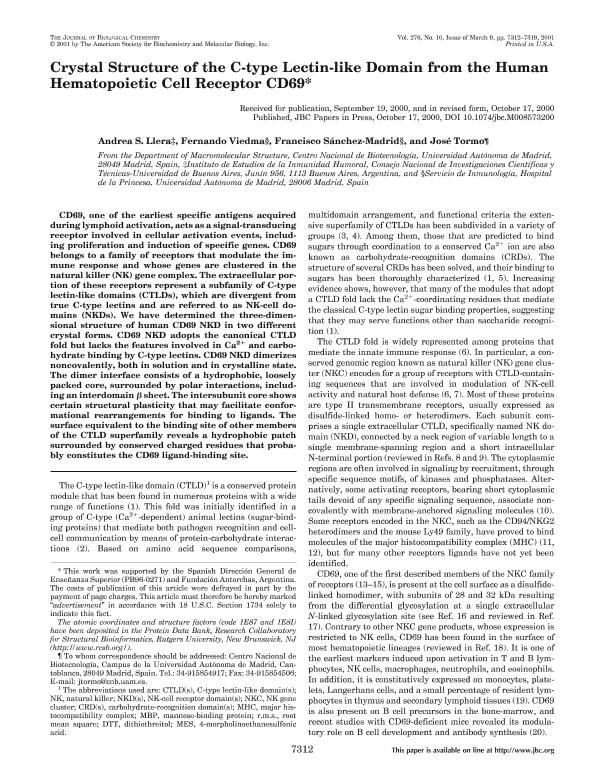Artículo
Crystal Structure of the C-type Lectin-like Domain from the Human Hematopoietic Cell Receptor CD69
Fecha de publicación:
03/2001
Editorial:
American Society for Biochemistry and Molecular Biology
Revista:
Journal of Biological Chemistry (online)
ISSN:
0021-9258
e-ISSN:
1083-351X
Idioma:
Inglés
Tipo de recurso:
Artículo publicado
Clasificación temática:
Resumen
CD69, one of the earliest specific antigens acquired during lymphoid activation, acts as a signal-transducing receptor involved in cellular activation events, including proliferation and induction of specific genes. CD69 belongs to a family of receptors that modulate the immune response and whose genes are clustered in the natural killer (NK) gene complex. The extracellular portion of these receptors represent a subfamily of C-type lectin-like domains (CTLDs), which are divergent from true C-type lectins and are referred to as NK-cell domains (NKDs). We have determined the three-dimensional structure of human CD69 NKD in two different crystal forms. CD69 NKD adopts the canonical CTLD fold but lacks the features involved in Ca(2+) and carbohydrate binding by C-type lectins. CD69 NKD dimerizes noncovalently, both in solution and in crystalline state. The dimer interface consists of a hydrophobic, loosely packed core, surrounded by polar interactions, including an interdomain beta sheet. The intersubunit core shows certain structural plasticity that may facilitate conformational rearrangements for binding to ligands. The surface equivalent to the binding site of other members of the CTLD superfamily reveals a hydrophobic patch surrounded by conserved charged residues that probably constitutes the CD69 ligand-binding site.
Palabras clave:
Antigens
,
Signal Transduction
Archivos asociados
Licencia
Identificadores
Colecciones
Articulos(IIBBA)
Articulos de INST.DE INVEST.BIOQUIMICAS DE BS.AS(I)
Articulos de INST.DE INVEST.BIOQUIMICAS DE BS.AS(I)
Citación
Llera, Andrea Sabina; Viedma, Fernando; Sánchez Madrid, Francisco; Tormo, José; Crystal Structure of the C-type Lectin-like Domain from the Human Hematopoietic Cell Receptor CD69; American Society for Biochemistry and Molecular Biology; Journal of Biological Chemistry (online); 276; 10; 3-2001; 7312-7319
Compartir
Altmétricas




